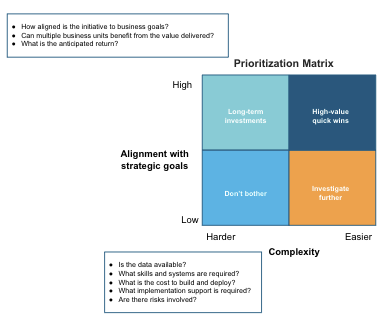Several years ago a Chief Data Officer asked me, “Is a dollar of cost savings the same as a dollar of revenue generated?” My response was a resounding “no.” Data and analytics initiatives must align with business objectives. If a company is in growth mode, hell-bent on capturing mind and market share, insights teams prioritize revenue generation over cost savings.
Source: Original Postress-this.php?">Ensure the View IS Worth the Climb
In a downturn, when survival mode kicks in, priorities might look a little different. This is the crux of developing a data strategy. It’s not an independent exercise. Building a data strategy is about identifying, prioritizing, and executing initiatives that best support a company’s business strategy and strategic objectives.
To Prioritize, You Need Priorities
While we often get caught up in the technology, the starting point is really the use case. What do you want to do? What are your business imperatives? And, voila, that’s how you get started. The New Yorker has joked about the discussion with the cartoon “If we’re going to prioritize, we’re going to need some priorities.” The first step is to get input from your business stakeholders to know what they need. And the role of the data leaders is to translate those needs into the people, process, technology, and data requirements to deliver.
The next step is to figure out what you want to do first. The discussion of prioritization brings to mind the proverbial jar of life, which represents time, with piles of rocks, pebbles, and sand that represent strategic initiatives, urgent but smaller projects, and more routine tasks or even busy work, respectively. What’s important to note here is that rocks are important. These are the big hard things that will really transform the business. A few years ago, another CDO told me that his “rock” was to identify a “rock.”
When teams are busy responding to a flood of requests from across the business, they risk not taking the time to identify those larger, more strategic projects that can drive transformation, competitive advantage, and differentiation. And, those are the projects that truly support the business strategy.
Prioritization Is as Much About What You Won’t Do as What You Will Do
Part of the prioritization exercise is to determine what not to do. It’s important to take a step back and make sure all the things you are currently doing still deliver value. Business insights teams get inundated with requests for dashboards and reports. Over time, however, interest wanes and these “derelict dashboards” no longer deliver value. The words of the gambler apply here as well: “Know when to hold ’em; know when to fold ’em.”
Another important lesson is “Just because you can doesn’t mean you should.” Think about a marketing exercise that might better target a customer segment with a postcard or a CD in the mail (remember those?). At some point the negative impact of those campaigns—as people begin to complain about junk mail and irresponsible marketing—outweigh the conversion rates that they may deliver. These risks could also be included in a prioritization exercise.

The Bottom Line: Ensure That the View Is Worth the Climb
A simple prioritization framework enables consistency and transparency into the process. Potential projects or analytic use cases can be evaluated based on alignment with business objectives on the one hand (including synergies across business units and potential returns) versus complexity of the project (including data availability, resource requirements, and potential risks).
The matrix puts potential projects into four categories that can be associated with the jar exercise. Long-term investments might be those harder rocks. They can potentially be broken down into smaller pieces that become the pebbles that are high-value quick wins that add up to the bigger transformation. The projects that are lower in alignment and easier to do constitute the sand. Make sure to evaluate whether or not they are really worth the time and effort. Finally, there are likely to be some that you just leave outside the jar.
Having a formal prioritization framework ensures that initiatives are evaluated equally and transparently, and that project or use case investments support business strategy. The process can be adopted centrally where a CDO runs a CoE that offers a full-service competency center, helping business units and functional teams with their business intelligence and advanced analytics requirements. Or it can be adopted in a more distributed manner where domains manage their own agendas. The key is in the methodology to evaluate projects consistently and the transparency in communicating that process across the organization. The process, wherever it is applied in the organization, also ensures, in the words of another CDO, that “the view is worth the climb.”
The post Ensure the View IS Worth the Climb appeared first on Snowflake.
Enjoyed this article? Sign up for our newsletter to receive regular insights and stay connected.

